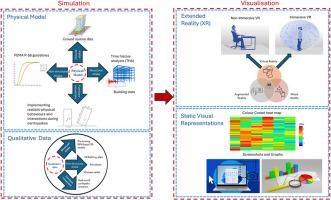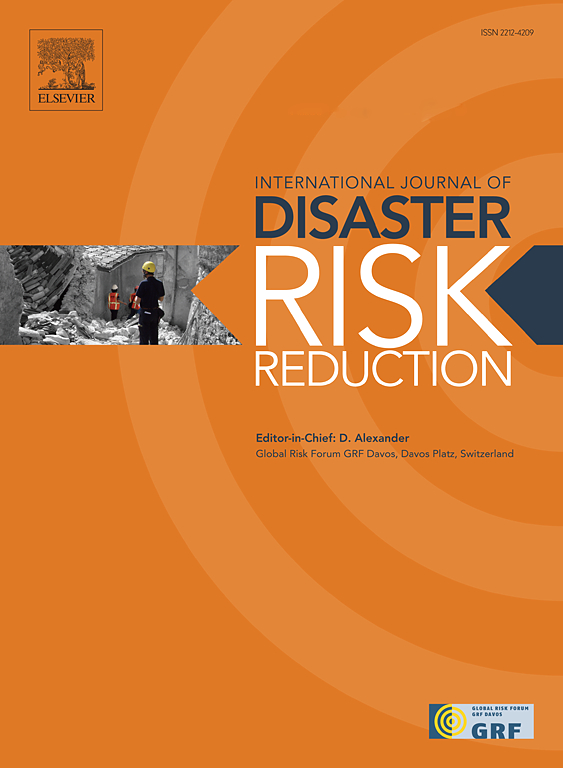Simulating and visualising indoor seismic damage: A systematic literature review
IF 4.5
1区 地球科学
Q1 GEOSCIENCES, MULTIDISCIPLINARY
International journal of disaster risk reduction
Pub Date : 2024-12-01
DOI:10.1016/j.ijdrr.2024.104979
引用次数: 0
Abstract
Earthquakes pose a significant risk to human lives because they can cause severe damage to structural and non-structural components of buildings, thereby harming building occupants. Accordingly, reducing earthquakes’ social, economic and environmental losses requires significant effort. Indoor seismic damage, which refers to damage caused by earthquakes inside buildings, such as falling objects, broken furniture and collapsed walls, is especially important for assessment and mitigation because it directly affects building occupants. Therefore, understanding and mitigating indoor seismic damage have become necessary. Many damage assessment tools have been introduced and adopted to assess the impact of earthquakes on buildings. Digital technologies can be essential in simulating and visualising earthquake damage, providing realistic, interactive and immersive experiences for different purposes and stakeholders. This systematic literature review critically aims to investigate existing approaches and methods for simulating and visualising indoor seismic damage to provide a comprehensive overview of the current state of research, identify knowledge gaps and offer insights into the future. Thus, a conceptual framework was developed, which integrates essential aspects, including methods and tools, to develop seismic damage simulation and visualisation. This objective was achieved by systematically reviewing 20 articles published between 2017 and 2023 to answer several research questions on the type of application, software, interoperability challenges and hardware adopted to visualise the damages.

模拟和可视化室内震害:系统的文献综述
地震对人类生命构成重大威胁,因为它们会对建筑物的结构和非结构部件造成严重破坏,从而伤害建筑物的居住者。因此,减少地震的社会、经济和环境损失需要付出巨大的努力。室内地震损害是指地震在建筑物内部造成的损害,如坠落的物体、损坏的家具和倒塌的墙壁,这对评估和减灾特别重要,因为它直接影响到建筑物的居住者。因此,了解和减轻室内地震破坏变得十分必要。许多损害评估工具被引入和采用来评估地震对建筑物的影响。数字技术在模拟和可视化地震破坏方面至关重要,为不同目的和利益相关者提供真实、互动和沉浸式体验。这篇系统的文献综述旨在调查模拟和可视化室内地震损伤的现有方法和方法,以提供对当前研究状况的全面概述,确定知识差距并为未来提供见解。因此,开发了一个概念性框架,它集成了包括方法和工具在内的基本方面,以开发地震破坏模拟和可视化。为了实现这一目标,我们系统地回顾了2017年至2023年间发表的20篇文章,以回答有关应用类型、软件、互操作性挑战和用于可视化损害的硬件的几个研究问题。
本文章由计算机程序翻译,如有差异,请以英文原文为准。
求助全文
约1分钟内获得全文
求助全文
来源期刊

International journal of disaster risk reduction
GEOSCIENCES, MULTIDISCIPLINARYMETEOROLOGY-METEOROLOGY & ATMOSPHERIC SCIENCES
CiteScore
8.70
自引率
18.00%
发文量
688
审稿时长
79 days
期刊介绍:
The International Journal of Disaster Risk Reduction (IJDRR) is the journal for researchers, policymakers and practitioners across diverse disciplines: earth sciences and their implications; environmental sciences; engineering; urban studies; geography; and the social sciences. IJDRR publishes fundamental and applied research, critical reviews, policy papers and case studies with a particular focus on multi-disciplinary research that aims to reduce the impact of natural, technological, social and intentional disasters. IJDRR stimulates exchange of ideas and knowledge transfer on disaster research, mitigation, adaptation, prevention and risk reduction at all geographical scales: local, national and international.
Key topics:-
-multifaceted disaster and cascading disasters
-the development of disaster risk reduction strategies and techniques
-discussion and development of effective warning and educational systems for risk management at all levels
-disasters associated with climate change
-vulnerability analysis and vulnerability trends
-emerging risks
-resilience against disasters.
The journal particularly encourages papers that approach risk from a multi-disciplinary perspective.
 求助内容:
求助内容: 应助结果提醒方式:
应助结果提醒方式:


